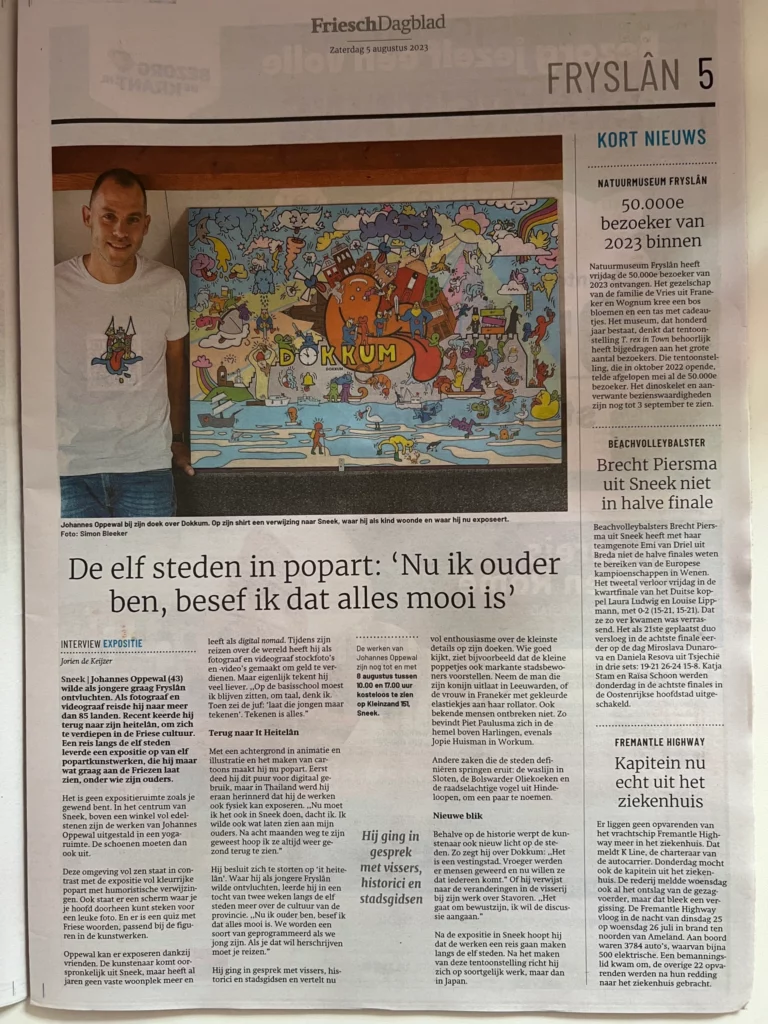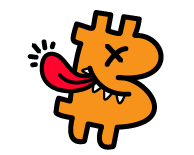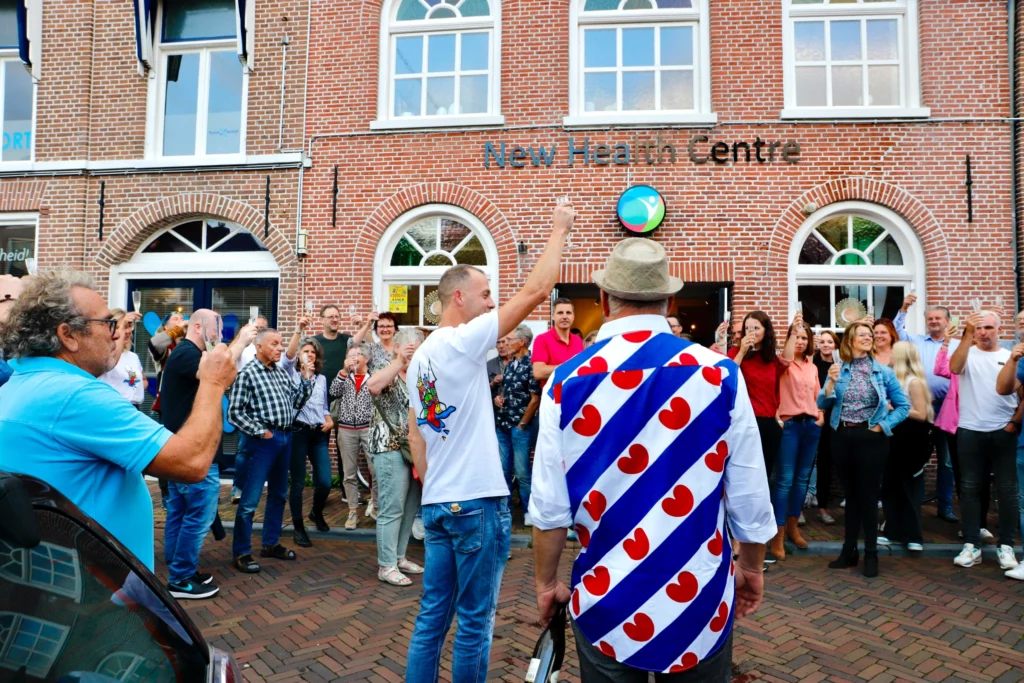The idea for PopArt Friesland came to me while I spent the winter of 2022/23 abroad, drawing about the cultures of Spain and Thailand. My art has the main themes such as love, freedom, and fun. (The tongue you often see in my art represents not taking life too seriously
Following your heart is the most important thing in my life, in traveling, and in how I create art.
2024 popUPart tour
*English description below
Na de 2023 expositie in Sneek genaamd ‘Heitelân’ Heb ik ook dit jaar weer een leuk art project voor Sneek gemaakt. Omdat ik veel reis en veelal in Azie leef valt het mij altijd op dat Nederland/Europa zo kleurloos is. Vandaar dat ik graag mijn geboortestad Sneek wat wil opvrolijken nu ik weer even terug ben.
Vanaf 20 Juni t/m eind Augustus kan je de POPupART Sneek tour doen. Zoek de poppetjes, noteer de letter en raad het woord. Lever je antwoord in bij Sterk en sVeer en maak kans op een mooie prijs. Deze tour is geheel gratis en dit alles had ik nooit kunnen realiseren zonder Joris van Copy to Print.
We wensen je een kleurrijke wandeling door Sneek.

After the 2023 exhibition in Sneek called ‘Heitelân,’ I have created another fun art project for Sneek this year. Since I travel a lot and often live in Asia, I always notice how colorless the Netherlands/Europe is. That’s why I want to brighten up my hometown of Sneek now that I’m back for a while.
From June 20th until the end of August, you can do the POPupART Sneek tour. Look for the little figures, note the letter, and guess the word. Submit your answer at Sterk and sVeer for a chance to win a great prize. This tour is completely free, and I could never have realized all this without Joris from Copy to Print.
We wish you a colorful walk through Sneek.
FRIESLAND
I (Johannes Oppewal) am born in the city Sneek (1980) in the province Friesland, also known as “Fryslân” in the Frisian language, is a province in the northern part of the Netherlands. It is a unique and distinct region with a rich cultural heritage and a strong sense of identity.
Friesland has a history of striving for freedom and independence. The Frisians fiercely defended their autonomy in the past, and this spirit of independence is still evident in their culture and traditions.Even though I’m often on the road for my art, I regularly come back to Friesland. That’s why in the summer of 2023, I have drawn the Frisian Eleven Cities in pop art style.
The Frisian Eleven Cities, known as the “Elfstedentocht” in Dutch, is a legendary ice skating race that covers a 200-kilometer route through eleven historic Frisian cities in the Netherlands. This event, often regarded as a true test of endurance, only takes place when the natural ice is thick enough to support the skaters. It has a special place in the hearts of the Frisian people, as it combines their love for winter sports, culture, and tradition.
While the ice skating event only occurs when the ice is thick enough, the same route can be enjoyed by cyclists throughout the year. Bicycling through the Eleven Cities is a fantastic way to explore the picturesque Frisian countryside and visit each city.
The Elfstedentocht is more than just a sporting event; it’s a cultural phenomenon that celebrates history, community, and the indomitable spirit of the Frisian people. It has a profound impact on the region, fostering unity, tradition, and a shared love for Friesland’s unique heritage.
The 11 cities are, to begin with the city where I am born:
* The first name is in Frisian, the second in Dutch
Exhibition 2023 photos
In 2023, the Heitelân exhibition was in 3 of the 11 cities: Sneek, Sloten, and IJlst. Unfortunately, I did not receive any further response when contacting them from the other 11 cities.
From August 4th to 9th, 2023, the first Heitelân exhibition took place at Kleinzand 151 in Sneek. More than 240 visitors attended the exhibition. From August 29th to September 1st, 2023, the second Heitelân exhibition took place in Sloten. Around 125 visitors attended the exhibition. On September 9th and 10th, 2023, the third Heitelân exhibition took place in IJlst. Around 100 visitors attended the exhibition.
Snits (Sneek)
Thema: Waterstad
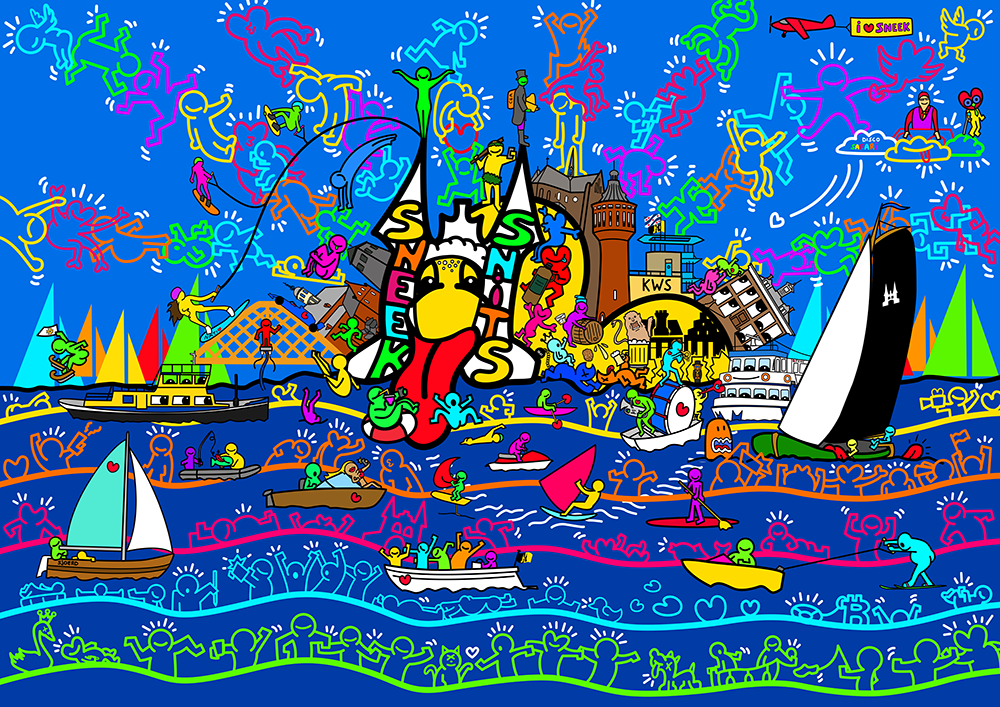
*English description below
Wat zie je:
De leeuw uit het stadswapen van Sneek die uit een biervat komt.
Vroeger luidde er een gebrul als er een biervat leeg was. Dit kwam vanuit het pand van ‘Onder de Linden’ zodat iedereen op de Marktstraat kon horen dat er weer een vat leeg was.
Je ziet de mensjes van de kroeg ‘t Ouwe Vat, De Kroon, Club 1841, Irish pub De Poort van Cleef, Weduwe Jouwstra en de nachtburgemeester Douwe Ka.
Club 1841 was vroeger een gevangenis, vandaar de stenen bal aan zijn voet. Een wiskey glas van Irish pub Poort van Cleef, Beerenburg van Weduwe Joustra. Recht boven in de wolken zie je bekende Sneekers die van ons zijn hee gegaan zoals Freekie en Dieter met zijn disco safari.
Al het overige is watersport waar Sneek bekend om staat, de Koninklijke Watersportvereniging, de waterski baan in het recreatiegebied De Potten, De Sneker Pan (het skûtsje van Sneek), het Startschip en de rondvaartboot Van der Werf. Maar ook een verwijzing naar de Sneekweek, zo zie je de Putkapel.
English
Topic: Water City
What do you see:
The lion from the city coat of arms of Sneek emerging from a beer barrel. In the past, there used to be a roar when a beer barrel was empty. This sound originated from the building of ‘Onder de Linden’ so that everyone on Marktstraat could hear that another barrel was empty. You see the people from the bars ‘t Ouwe Vat, De Kroon, Club 1841, Irish pub De Poort van Cleef, Weduwe Jouwstra, and the night mayor Douwe Ka.
Club 1841 used to be a prison, hence the stone ball at its foot. A whiskey glass from Irish pub Poort van Cleef, Beerenburg from Weduwe Joustra. In the clouds at the top, you can see familiar Sneekers who have passed away, like Freekie and Dieter with his disco safari.
All the rest depicts watersports for which Sneek is famous, such as the Royal Watersports Association, the water ski course in the recreational area De Potten, De Sneker Pan (the skûtsje of Sneek), the Start Ship, and the sightseeing boat Van der Werf. There’s also a reference to the Sneekweek, as you can see the Putkapel.
Drylts (IJlst)
Thema: Houtstad
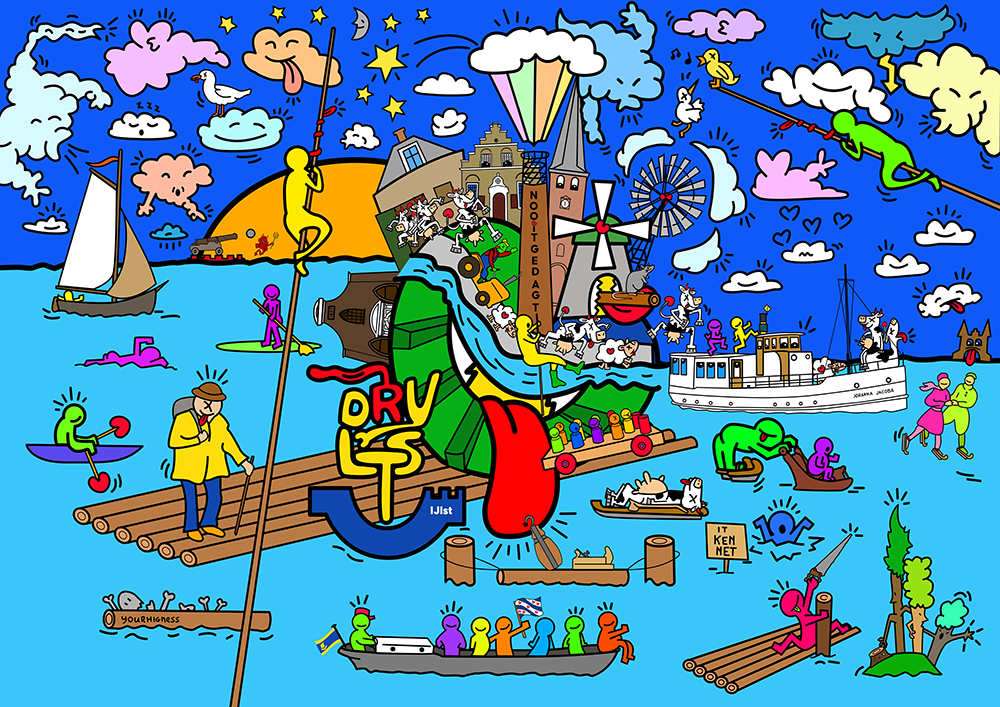
*English description below
Wat zie je:
Houtmolen de Rat – (300 jaar oud, staat 200 jaar IJlst) en nog in werking/ It Kypmantsje/ De typische overtuinen aan de gracht in IJlst.
IJlst had vroeger geen bolwerken. Maar om de stad ‘s nachts wel af te sluiten werden er palen/ boomstammen neergelegd als vesting. IJlst was een echte Houtstad. Houten schepen werden hier gebouwd of gerepareerd. Er was veel hout nodig, IJlst had dan ook een levendige houthandel. Het hout werd op grote houten vlotten getransporteerd. Het bedrijf Nooitgedagt heeft een grote rol gespeeld in dit alles en maakte houten speelgoed, schaatsen en gereedschap.
De Johanna Jacoba, ze vaart nog steeds met toeristen, was een Beurtschip en voer op Sneek met diverse lading. Zoals mensen maar ook koeien/schapen.
In sommige huizen woonde een koemelker, je kunt aan de huizen zien waar een koemelker woonde. De voordeuren zijn breder dan normaal zodat het vee door de gang kon lopen. Er is nog één stadsboer actief in IJlst.
Kogge – Is een schip zonder roer en het icoon van IJlst. In kampen ligt er nog een nagebouwd exemplaar.
In de vroege middeleeuwen werden bomen gebruikt als doodskist. Je ziet hier een dergelijk boomstamgraf.
English
Topic: Wood City
What do you see:
Wooden mill “De Rat” – (300 years old, standing in IJlst for 200 years) and still in operation / “It Kypmantsje” / The typical gardens along the canal in IJlst.
In the past, IJlst didn’t have ramparts, but to close off the city at night, posts/ tree trunks were laid down as fortifications. IJlst was a true Wood City. Wooden ships were built or repaired here, requiring a significant amount of wood, thus resulting in a lively timber trade. The wood was transported on large wooden rafts. The company “Nooitgedagd” played a significant role in all of this and produced wooden toys, skates, and tools.
The “Johanna Jacoba,” which still sails with tourists, was a cargo ship (“Beurtschip”) that used to sail to Sneek with various cargoes, including people and cattle/sheep.
In some houses, a farmer lived, and you can identify the houses where a farmer lived. The front doors are wider than usual, allowing the livestock to pass through the hallway. There is still one city farmer active in IJlst.
The “Kogge” – a ship without a rudder and an icon of IJlst. There is a replica of it in Kampen.
In the early Middle Ages, trees were used as coffins. Here you can see such a tree trunk grave.
Sleat (Sloten)
Thema: Mislukte verovering van de vestingsstad

Wat zie je:
De mislukte verovering van Sloten door de Spanjaarden is een bekend verhaal. De Spanjaarden zaten in de nacht van de verovering in biertonnen op hun schip. Maar zij werden zeeziek door de golfslag op het Slotermeer. De verovering ging dus ook total mis! De kapitein was echter Pier Lupckes; een boer uit het naastliggende dorp Tjerkgaast. Na een rechtsgang werd Pier voor het publieke onthoofd. Deze rechtsgang wordt om de 3 jaar nagespeeld in de stad Sloten. De Stadsomroeper kondigt iedere vrijdag in de zomer het kanonschieten aan.
Sloten is de kleinste stad van alle 11 steden. Kenmerkend is de gezamenlijke waslijn.
De stad Sloten is in een vorm van een ui gebouwd. Vandaar dat het ook wel de sipelstêd (uistad) wordt genoemd. In mijn tekening zie je daarom een mannetje met een ui. Jaarlijks wordt de sipelsneon georganiseerd in Sloten. Een zaterdag met een markt en festiviteiten.
Onderaan de tekening zie je De Wyldsjitter (wildschieter) is een smal jagers bootje. In deze afbeelding jaagt iemand op de houten vogels van de bekende Sloter ‘Jelle Bobo’.
Sloten was de sleutel tot de zuiderzee. Als je door Sloten voer, werd er tol geheven. Eerst dus op boten en later ook op andere voertuigen zoals auto’s, motoren en ook de fiets. Er werd per wiel afgerekend, dit is per 1 januari 1951 opgeheven. In Sloten wordt nog bruggeld betaald, de munten worden in een Fries klompje door de brugwachter opgehaald. Het Friese woord voor brugwachter vind ik ook weer mooi: Brêggewippe.
English
Topic: Failed Conquest of the Fortress City
What do you see:
The failed conquest of Sloten by the Spaniards is a well-known story. The Spaniards hid in beer barrels on their ship on the night of the conquest. However, they became seasick due to the waves on the Slotermeer. The conquest was a total failure! The captain was Pier Lupckes, a farmer from the neighboring village of Tjerkgaast. After a trial, Pier was publicly beheaded. This trial is reenacted every three years in the city of Sloten. The Town Crier announces the cannon shooting every Friday in the summer.
Sloten is the smallest city among all 11 cities in the region. One of its characteristic features is the shared clothesline.
The city of Sloten is built in the shape of an onion, which is why it is also called the “sipelstêd” (onion city). In my drawing, you can see a little figure with an onion. Every year, the “sipelsneon” is organized in Sloten, a Saturday with a market and festivities.
At the bottom of the drawing, you see “De Wyldsjitter” (wild shooter), which is a narrow hunting boat. In this image, someone is aiming at the wooden birds of the famous Sloter, “Jelle Bobo.”
Sloten was the key to the Zuiderzee. When passing through Sloten, tolls were levied, initially on boats and later on other vehicles such as cars, motorcycles, and even bicycles. Toll was charged per wheel until it was abolished on January 1, 1951. In Sloten, bridge toll is still paid, and the coins are collected by the bridge operator in a traditional Frisian wooden shoe, called a “klompje.” The Frisian word for a bridge operator, “Brêggewippe,” is also funny.
Starum (Stavoren)
Thema: Vrijgevochten
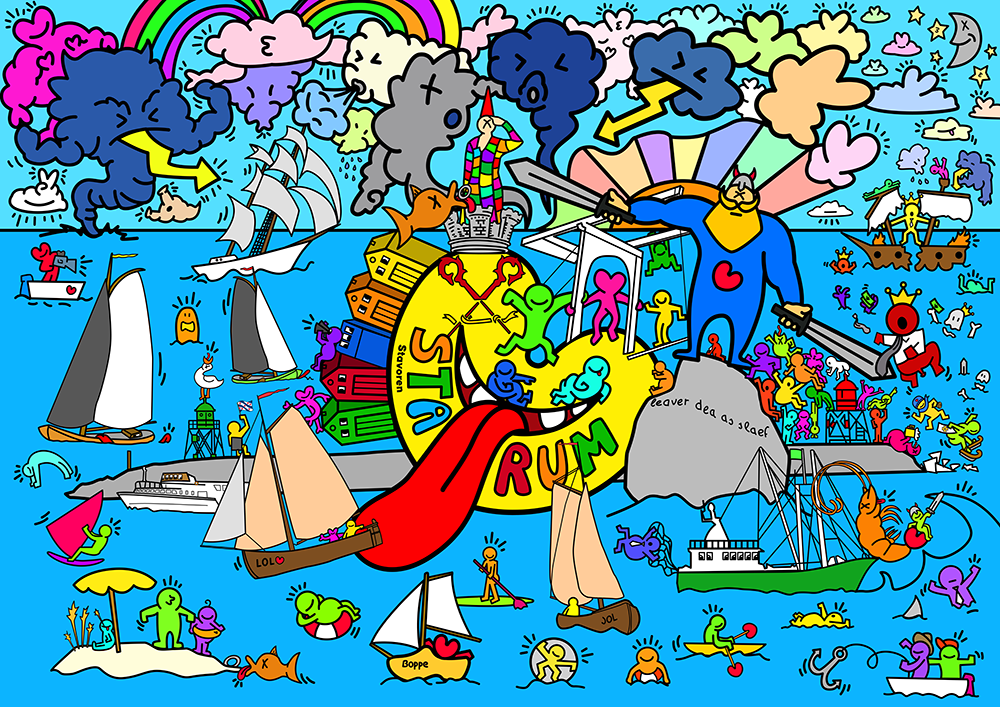
Wat zie je:
Stavoren wordt ook wel Staveren genoemd, en in het Fries is het Starum. Het is niet echt duidelijk waar Staveren vandaan komt..
In deze afbeelding zie je diverse boten, skûtsjes, garnalenkotter, rondvaartboten en ook de Staverse Jol. Een Staverse Jol is een rondbodem, wat betekent dat het een kiel heeft en geen zwaarden nodig heeft om te kunnen koersen. Het werd vroeger veel gebruikt voor de visserij op de Zuiderzee, het had een open kuip om de vangst te kunnen bergen. Tegenwoordig zien we kotters voor de visserij, een heel ander soort schip. In mijn afbeelding zie je de strijd tussen de visserij en opgelegde maatregelen vanuit de overheid. Een soort strijd die in de middeleeuwen ook al werd gevoerd; Grutte Pier Gerlofs Donia was een vrijheidsstrijder die vocht tegen de graven van Holland toen zij besloten om Fryslân te willen overnemen. Jaarlijks wordt in bij Rea Klif deze strijd herdacht.
Het vrouwtje van Stavoren is erg bekend, deze sage heb ik in twee illustraties afgebeeld. Het verhaal gaat dat het graan wat in de Zuiderzee weggegooit moest worden, terecht kwam op een zandbank. Daar is het graan gaan groeien.
https://www.waterlandvanfriesland.nl/nl/stavoren/vrouwtje-van-stavoren
English
Topic: Free-spirited
What do you see:
Stavoren, also known as Staveren, is called “Starum” in Frisian. The origin of the name Staveren is not entirely clear.
In this image, you can see various boats, skûtsjes, shrimp cutters, tour boats, and the Staverse Jol. A Staverse Jol is a round-bottomed boat, which means it has a keel and doesn’t require swords to steer. It was commonly used for fishing in the Zuiderzee and had an open cockpit to store the catch. Nowadays, we see trawlers for fishing, a completely different type of ship. In my illustration, you can see the struggle between the fishing industry and government-imposed regulations. A kind of struggle that dates back to the Middle Ages, just like Grutte Pier Gerlofs Donia, a freedom fighter who fought against the counts of Holland when they sought to take over Fryslân. This battle is commemorated annually near Rea Klif.
The Lady of Stavoren is very well-known, and I have depicted this legend in two illustrations. The story goes that the grain that was thrown into the Zuiderzee ended up on a sandbank and grew there.
https://www.waterlandvanfriesland.nl/en/locations/2435624490/the-lady-of-stavoren
Hylpen (Hindeloopen)
Thema: Schilderkunst
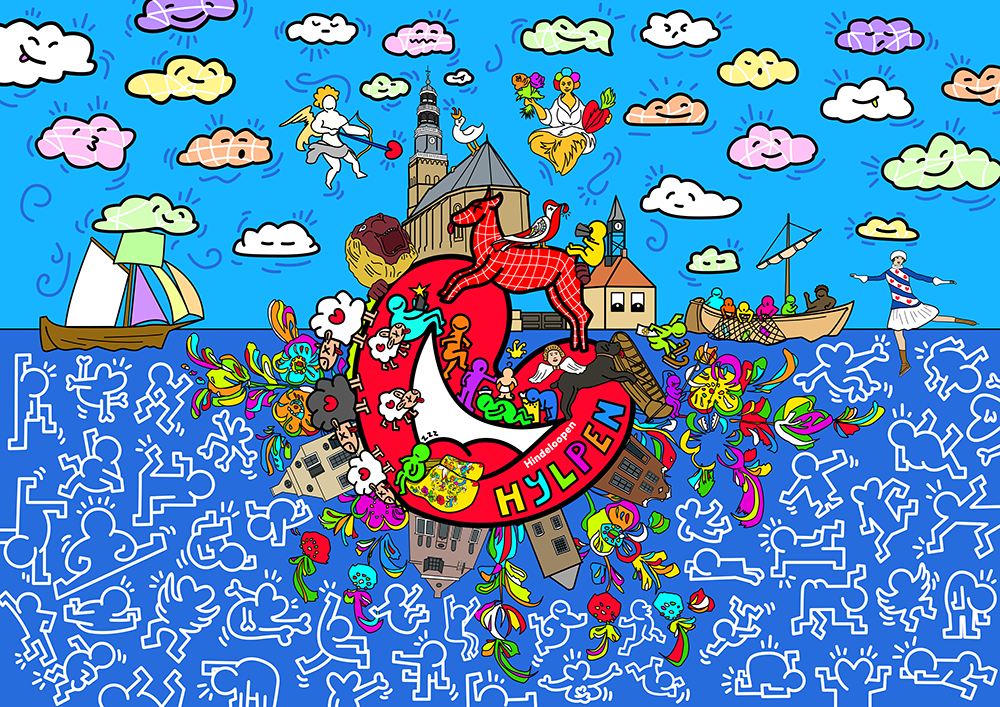
Wat zie je:
Hindeloopen staat bekend om haar schilderkunst. De vaak afgebeelde vogel is een illustratie meegekomen uit de vele handelsreizen naar Indië en wordt ook wel gezien als geluksvogel.
De lijntjes in het hert verwijzen naar de klederdracht van de Hylpers. Je ziet de lijntjes terugkomen in de schapenwolken die op hun beurt weer verwijzen naar de typisch aanwezige schapen op de dijk.
De legende van Ame Gijs (1) is bijzonder leuk om te ontdekken, het verhaal ontdek je aan de Achtvoet. Maar wat dacht je van het Kweade Wiif fan Hylpen? (2) Het gaat om een verhaal over een schipper, zijn vrouw en zijn hond. Een herinnering aan dit volksverhaal is nog te vinden aan de Buren in Hindeloopen. Je snapt; een bezoek aan Hindeloopen is het zeker waard.
- https://kunst-en-cultuur.infonu.nl/mythologie/188865-ame-gijs-een-volksverhaal-uit-hindeloopen.html
- https://www.waterlandvanfriesland.nl/nl/locaties/2759264433/sage-it-kweade-wiif-fan-hylpen
English
Topic: Painting Art
What do you see:
Hindeloopen is renowned for its painting art. The often depicted bird is an illustration that came from the many trade voyages to the Dutch East Indies and is also seen as a lucky bird.
The lines in the deer refer to the traditional clothing of the people from Hindeloopen. You can see these lines reappearing in the sheep clouds, which in turn refer to the sheep typically present on the dike.
The legend of Ame Gijs is fascinating to discover; you can learn about the story at the Achtvoet. But what about the “Kweade Wiif fan Hylpen” (Evil Wife of Hindeloopen)? It’s a story about a skipper, his wife, and his dog. A memory of this folk tale can still be found at the Buren in Hindeloopen. As you can imagine, a visit to Hindeloopen is definitely worthwhile.
(Note: The translation may not fully capture the cultural and historical context of the mentioned legends and places, but it provides a general understanding of the described elements related to painting art in Hindeloopen.)
Warkum (Workum)
Thema: Mienskip (samenleving)
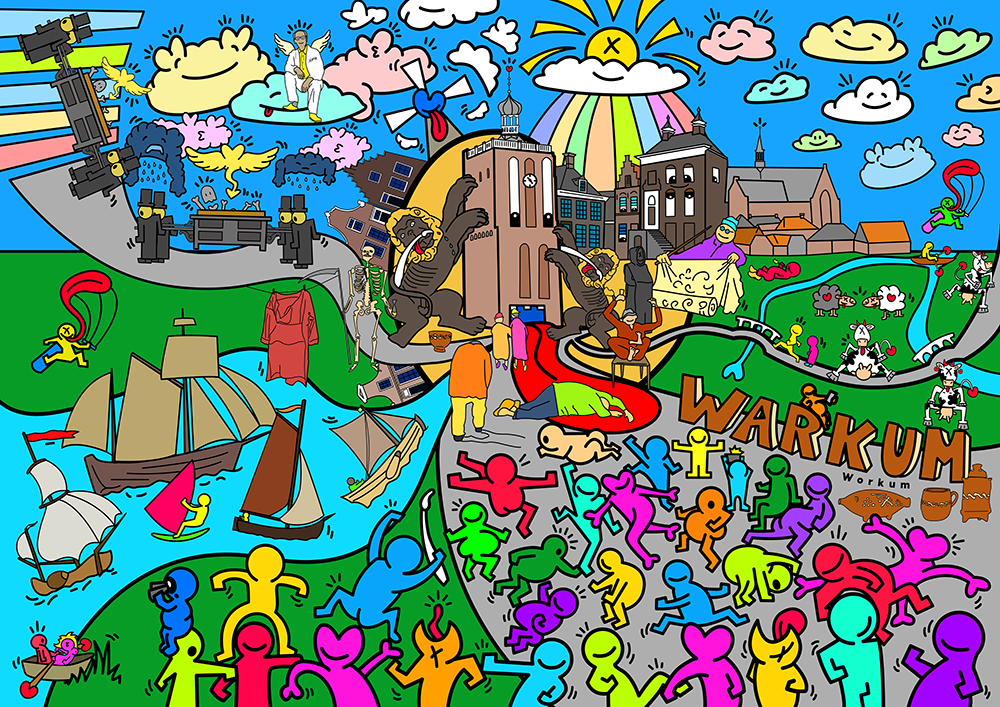
Wat zie je:
Het is wel typisch om alleen een kerktoren in Workum te zien, die los staat van de kerk. De Workumertoren werd gebouwd maar het geld was op. De kerk is later, los van de toren, gebouwd.
In de kerk staat een unieke collectie gildebaren. Het beroep wat de dode uitoefende werd op de baar geschilderd. Deze doodsbaren zijn sinds 1973 niet meer in gebruik.
De Tillefoane is een historisch kerkepad met 8 kleine bruggetjes tussen de dijk van de voormalige Zuiderzee en de stad Workum. Alle paden leiden naar Workum, behalve de dood.
Ontdek de schilderingen van Jopie Huisman!
Naast de Leeuwenfontein, uit de 11-fountains reeks, werd als parodie daarop de pauperfontein gemaakt. Deze staat inmiddels niet meer in Workum maar heeft wel gezorgd voor de nodige reuring.
Het algemene gemiddelde van een el is 69,4 cm. In iedere handelscentrum werd de maat van de el vastgesteld, in Workum wat dat 70,9. Een replica van de el vind je op de muur van het stadhuis. Deze maat werd gehanteerd bij het uitmeten van stoffen.
English
Topic: Community (Society)
What do you see:
It’s quite typical to only see a church tower in Workum, standing apart from the church itself. The Workumertoren was built, but the money ran out. Later, the church was constructed separately from the tower. Inside the church, you can find a unique collection of guild biers. The profession of the deceased was painted on the bier. These death biers have not been in use since 1973.
The “Tillefoane” is a historical church path with 8 small bridges between the dike of the former Zuiderzee and the city of Workum. All paths lead to Workum, except for the path of death.
Discover the paintings of Jopie Huisman!
In addition to the Lion Fountain, part of the 11-fountains series, a parody of it was created called the “pauperfontein.” This fountain is no longer in Workum but caused quite a stir.
The average length of an “el” is 69.4 cm. In every trading center, the measurement of an el was determined, and in Workum, it was 70.9 cm. A replica of the el can be found on the wall of the town hall. This measurement was used for measuring fabrics.
(Note: The translation may not fully capture the cultural and historical context of the mentioned elements related to the community and society in Workum, but it provides a general understanding of the described features.)
Boalsert (Bolsward)
Thema: Elfstedentocht; fiets en step

Wat zie je:
In de Franciscusbasiliek is in een zijkapel de 13e-eeuwse houten sculptuur van een tronende Maria en kind aangebracht, dat geldt als een mirakelbeeld en trekt veel pelgrims aan.
Naast de basiliek staan vijf gevelpanden. Op zich niets vreemd ware het niet dat ze hier naast elkaar staan. Bolsward mag trouwens graag ‘vlaggen’. Bij veel gebeurtenissen steekt men de vlag uit, altijd reden voor een feestje.
Inwoners van Bolsward worden ‘oaljekoeken’ (oliekoeken) genoemd. Een geuzennaam. Het verwijst naar een oude legende in Bolsward, van houtsnijder Rommert die een moeilijk werkstuk moest maken en telkens faalde. Toen kwam de duivel om de hoek, die wel van een koek hield en de vlucht sloeg met een larf van de bonte knaagkever aan zijn drietand. Hoe dit verder zit, moet je maar zelf ontdekken.
Op de tandem zit voorop de Stadsomroeper, dan de Heakeninginne, Us Heit, een boer met zijn koe, een Fries mensje, de kokkin van de Oaljekoek, Beerenburg, Mukkes de kabouter, It Frysk Hynder en een ringrijder. Let op, ga niet te ver want na Nijland moet de Boalserter kotsen.
Op de eerste donderdag van oktober wordt er goed veehandel gedreven op Bolletongersdei.
English
Topic: Eleven Cities Tour; Bicycles and Step
What do you see:
In the Franciscus Basilica, a 13th-century wooden sculpture of a seated Mary and child is placed in a side chapel, which is considered a miraculous image and attracts many pilgrims.
Next to the basilica, there are five facade buildings standing side by side. While it might not seem strange on its own, Bolsward is fond of flagging. For many events, they raise flags, always a reason for celebration.
Inhabitants of Bolsward are called “oaljekoeken” (oil cakes), which is a nickname they embrace. It refers to an old legend in Bolsward about the woodcarver Rommert who had to make a difficult workpiece and failed repeatedly. Then the devil appeared, who loved a cake and fled with a larva of the varied carpet beetle on his trident. To discover how this story unfolds further, you’ll have to find out yourself.
On the tandem, you see the Town Crier at the front, followed by the Queen of the Heakeninginne, Us Heit, a farmer with his cow, a Frisian character, the cook of the Oaljekoek, Beerenburg, Mukkes the dwarf, It Frysk Hynder, and a ring rider. Be careful not to go too far, as the Boalserter might feel nauseous after Nijland.
On the first Thursday of October, good livestock trading takes place during “Bolletongersdei.”
Harns (Harlingen)
Thema: Komen en gaan

Wat zie je:
Harlingen is een echte reizigersstad. Mensjes komen en gaan, niet alleen van en naar de eilanden maar van oudsher vanwege de rijke handel. Harlingen werd ook wel de voorstad van London genoemd. Op het eerste stenen gebouw werd een gouden engel geplaatst, het was het bordeel van Harlingen.
Bij de oude sluis staat een huis gebouwd met grote bakstenen. Het verhaal gaat dat wanneer de sluis niet werkt, men het huis kan laten instorten om Harlingen van overstroming te behoeden.
De brug is opgeluisterd met 4 standbeelden van leeuwen. Zij kijken allemaal naar hetzelfde punt van de brug om deze te bewaken. Daardoor lijkt het dat ze scheel kijken. De sage gaat dat wanneer je na 12 uur ‘s nachts over de brug loopt, je scheel gaat kijken.
Harlingen heeft veel kattestegen. Een kat kon de steeg wel in maar vaak niet uit. Met dode katten tot gevolg. Daarom werd de steeg met een katteplank dichtgetimmerd.
Er is van oudsher een rivaliteit tussen Harlingen en Franeker. De Franekers worden door de Harlingers beschuldigd als klokkendieven. Gezegd wordt dat als de Franekers vervelend zijn, de Harlingers de sluisdeuren opendoen zodat Franeker onderstroomd.
English
Topic: Arrival and Departure
What do you see:
Harlingen is a true travelers’ city. People come and go, not only to and from the islands but historically because of its prosperous trade. Harlingen was also known as the suburb of London. A golden angel was placed on the first stone building, which was Harlingen’s brothel.
Next to the old lock stands a house built with large bricks. The story goes that when the lock doesn’t work, people can let the house collapse to save Harlingen from flooding.
The bridge is adorned with four statues of lions. They all look towards the same point on the bridge to guard it. As a result, they appear cross-eyed. The legend says that if you walk over the bridge after midnight, you’ll go cross-eyed too.
Harlingen has many “kattestegen” (cat alleys). Cats could enter the alleys but often couldn’t find their way out, leading to dead cats. That’s why the alleys were closed off with a “katteplank” (cat plank).
There has always been rivalry between Harlingen and Franeker. The people from Franeker are accused by the Harlingers of stealing bells. It is said that when the Franekers are annoying, the Harlingers open the lock gates, causing Franeker to be flooded.
Frjentsjer (Franeker)
Thema: Een geestelijke stad
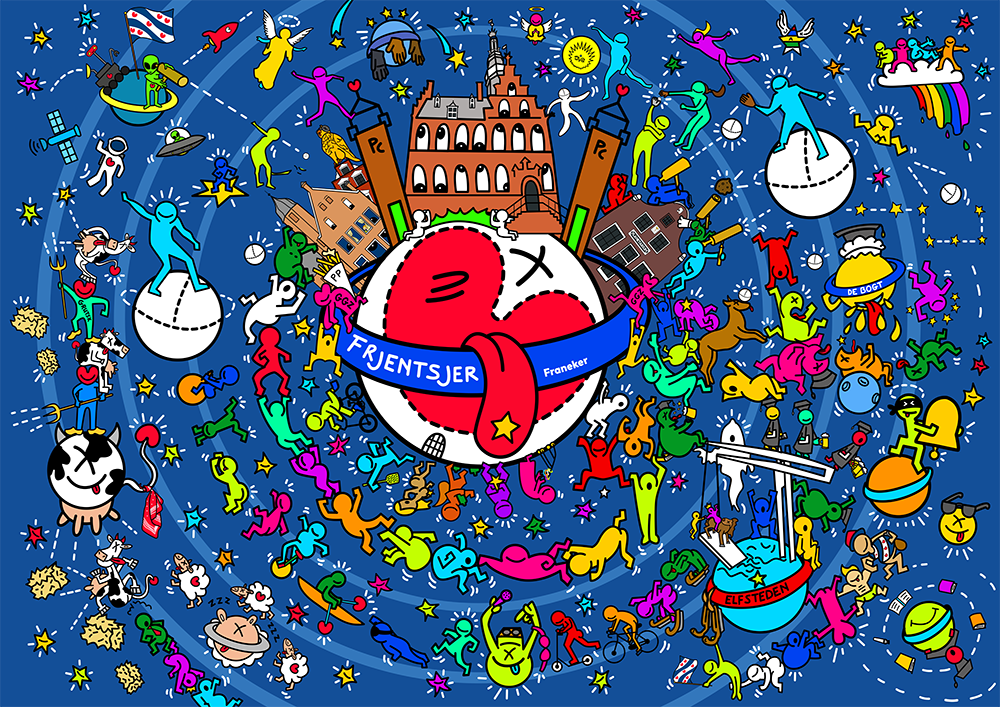
Wat zie je:
Ontdek de Franeker klokkedief!
Franeker is van oudsher een universiteitsstad, het werd bewoond door veel academici. Het academisch niveau ging echter rap achteruit toen in de 17e eeuw het water besmet raakte, accijns van drank afgehaald werd en dus alcohol goedkoper werd…. De Bogt is de eerste studentensocieteit, tegenwoordig is het een café.
Uit Franeker kwam de eerste vrouwelijke hooggeleerde, Anna Maria van Schuurman. Zij woonde in haar jeugd in Martenastins en studeerde in het geheim omdat ze vrouw was. Je ziet haar afgebeeld in haar geboortewoning achter een gordijntje.
De ‘heilige grond’ van de PC herbergt de gezegde; ‘Hjir rekket de bal it hert’ Als Hollander denk je al snel aan een hert.
Alle mensjes zweven in het universum, een verwijzing het planetarium.
English
Topic: A Spiritual City
What do you see:
Discover the Franeker bell thief!
Franeker has traditionally been a university city, inhabited by many academics. However, the academic level declined rapidly in the 17th century when the water became contaminated, and taxes on alcohol were removed, making alcohol cheaper…. De Bogt was the first student society, which is now a café.
From Franeker came the first female scholar, Anna Maria van Schuurman. She lived in her youth in Martenastins and secretly studied because she was a woman. You can see her depicted in her birthplace behind a curtain.
The “holy ground” of the PC carries the saying, “Hjir rekket de bal it hert,” which, as a Hollander, you might quickly think of a deer.
All the people are floating in the universe, referring to the planetarium.
Dokkum (Dokkum)
Thema: Vestigingstad; toen en nu

Wat zie je:
In Dokkum werden vroeger de kwaadaardige mensjes buiten de vesting gehouden om zichzelf te beschermen. De mensjes van Dokkum moesten wel voor 10 uur ‘s avonds uur binnen de vesting zijn. Een oproep werd gedaan via de klok, die luidde toen en nu om 10 voor 10.
Bij de Waag werd tol geheven maar er werd door kinderen ook met de tol gespeeld. Omdat bij de Waag het enige stukje straat was wat verhard was. Ook hier werd er voldoende bier gedronken, gebrouwen door de Halve Maan, en liepen mensjes tollend weer naar huis.
Het verhaal van de granaet gaat over een reusachtige garnaal. Zo’n groot beest hadden ze in Dokkum nog niet eerder gezien en het werd aan een zilveren ketting onder de Zijl gelegd. Het lag geketend tot het moment dat Prins Frederik Hendrik in Dokkum op bezoek zou komen. Die kwam niet, de granaet ligt nog geketend, dus moeten de vissers uit Stavoren hem maar bevrijden.
Bonifatius kennen we wel van Dokkum, ook dat hij vermoord is om zijn boodschap. Dat was vroeger. Nu bestaat het christelijke geloof vreedzaam naast bijvoorbeeld het boeddhisme. In het plaatsje Hantum staat een boeddhistische stoepa.
De uitspraak: “Alle mensjes in Dokkum sûpe, zelfs de vogels’ vertelt het verhaal van de 400 jaar oude Moerbijboom naast de kerk, de oudste van Europa. De besjes bevatten blijkbaar een stof waar de vogels dronken van worden.
De doodskistenopstand: Uitvaartondernemers gingen in opstand omdat van hoger hand regels werden opgelegd. De lijkenkisten stapelden zich op….handhaving uit Leeuwarden kwam om daar een einde aan te maken.
Dokkum welkom aan het Wad, vergeet niet je Wadlaarzen mee te nemen.
English
Topic: Fortified City; Then and Now
What do you see:
In Dokkum, the malicious people were once kept outside the fortification to protect themselves. The people of Dokkum had to be inside the fortification by 10 p.m. A call was made through the bell, which rang then and now at 10 minutes to 10.
At the Waag, tolls were collected, but children also played with spinning tops there. Because the area around the Waag was the only part of the street that was paved. Here, plenty of beer was drunk, brewed by the Halve Maan, and people walked home spinning.
The story of the “granaet” (giant shrimp) is about a gigantic shrimp that was seen in Dokkum for the first time. It was chained to a silver chain under the Zijl bridge until Prince Frederik Hendrik would visit Dokkum. He never came, so the “granaet” remains chained, and the fishermen from Stavoren will have to set it free.
We know about Boniface and his murder in Dokkum for his message. That was in the past. Now, the Christian faith coexists peacefully alongside, for example, Buddhism. In the village of Hantum, there is a Buddhist stupa.
The saying: “All the people in Dokkum drink, even the birds” tells the story of the 400-year-old Mulberry tree next to the church, the oldest in Europe. The berries apparently contain a substance that makes the birds intoxicated.
The Coffin Uprising: Funeral directors rebelled against imposed rules from higher authorities. The coffins piled up… enforcement from Leeuwarden came to put an end to it.
Dokkum welcomes you to the Wadden Sea, don’t forget to bring your Wadden boots.
Ljouwert (Leeuwarden)
Thema: Skeef (Scheef)
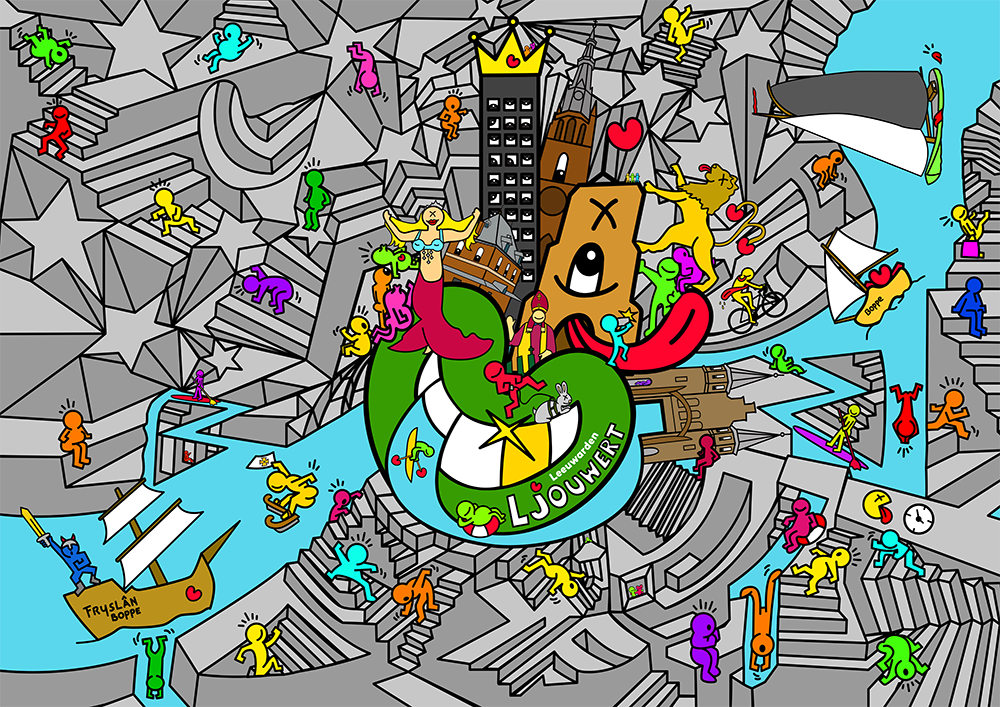
Wat zie je:
Olde hove, kien, wat staast weer skeef, als ik voorbij bin, bin ik blied dat ik nog leef.
Toen ik deze tekst hoorde, wist ik dat ik hier iets mee moest doen. De Leeuw houdt nu de Oldehove vast zodat hij niet omvalt. En uiteraard maken de mensjes een foto waarbij ze de toren tegenhouden voor het vallen.
Naast dat Skeef een thema is in Leeuwarden komt de beroemde kunstenaar M.C. Escher hier vandaan. Vandaar de achtergrond geïnspireerd door M.C. Escher.
Maar waarom heeft de Leeuw 2 staarten? Op de gebouwen van Leeuwarden gebouwd voor 1850, werd de staart van de Leeuw in het stadswapen naar buiten getekend. Na 1850 werd de staart naar binnen getekend. Blijkbaar hebben ze een fout gemaakt en kwamen ze daar pas later achter.
Wist je dat de betekenis van de naam Leeuwarden niets met een Leeuw te maken heeft?
Ljouwert, de Friese naam, herbergt het woord ‘wert’. Dit woord is een afgeleid van het Germaanse woord -wurth wat oorspronkelijk ‘verhoogde woonplaats, terp’ betekende. De Oldehove is, per ongeluk, deels gebouwd op een terp. Je kunt bedenken wat er dan door de tijd gebeurde met deze toren. Diverse dorpen in Friesland hebben dit woord in de naam, bijvoorbeeld Bolsward, Britswert, Wiuwert en Kimswerd.
Verder zie je Mata Hari, de exotische danseres, hofdame/minnares én spion uit Leeuwarden. https://nl.wikipedia.org/wiki/Mata_Hari. En je ziet bekende/bijzondere mensen uit Leeuwarden. Zoals de man die zijn konijn uitlaat en de ‘paus’ van Leeuwarden.
De mensjes lopen alle kanten op, zoals je in elke stad ziet. Druk bezig met van alles en nog wat.
English
Topic: Skeef (Skew)
What do you see:
‘Olde hove, kien, wat staast weer skeef, als ik voorbij bin, bin ik blied dat ik nog leef. ‘
Olde hove, kien, what do you stand again skew, when I pass by, I am glad that I am still alive.
When I heard this text, I knew I had to do something with it. The lion now holds the Oldehove so that it doesn’t collapse. And of course, people take a photo while they support the tower from falling.
Besides Skew (Skeef) being a theme in Leeuwarden, the famous artist M.C. Escher also comes from here. Hence the background inspired by M.C. Escher.
But why does the lion have 2 tails? On the buildings built in Leeuwarden before 1850, the lion’s tail in the city coat of arms was drawn outward. After 1850, the tail was drawn inward. Apparently, they made a mistake and only realized it later.
Did you know that the meaning of the name Leeuwarden has nothing to do with a lion? Ljouwert, the Frisian name, contains the word ‘wert.’ This word is derived from the Germanic word ‘wurth,’ originally meaning ‘elevated dwelling place, mound.’ The Oldehove was accidentally partly built on a mound. You can imagine what happened to this tower over time. Various villages in Friesland have this word in their name, for example, Bolsward, Britswert, Wiuwert, and Kimswerd.
Furthermore, you see Mata Hari, the exotic dancer, court lady/mistress, and spy from Leeuwarden.
https://en.wikipedia.org/wiki/Mata_Hari. And you see well-known/remarkable people from Leeuwarden, like the man walking his rabbit and the ‘pope’ of Leeuwarden.
The people are walking in all directions, as you see in every city. Busy with all sorts of things.
More Friesland
Title: Terug Naar Terschelling

In The Media
2024
2023
Groot Fryslân
https://www.grootfryslan.nl/grootfryslan/heitelan-expositie-van-kunstenaar-johannes-oppewal
Friesch Dagblad
https://frieschdagblad.nl/cultuur/De-elf-steden-in-popart-28576518.html
